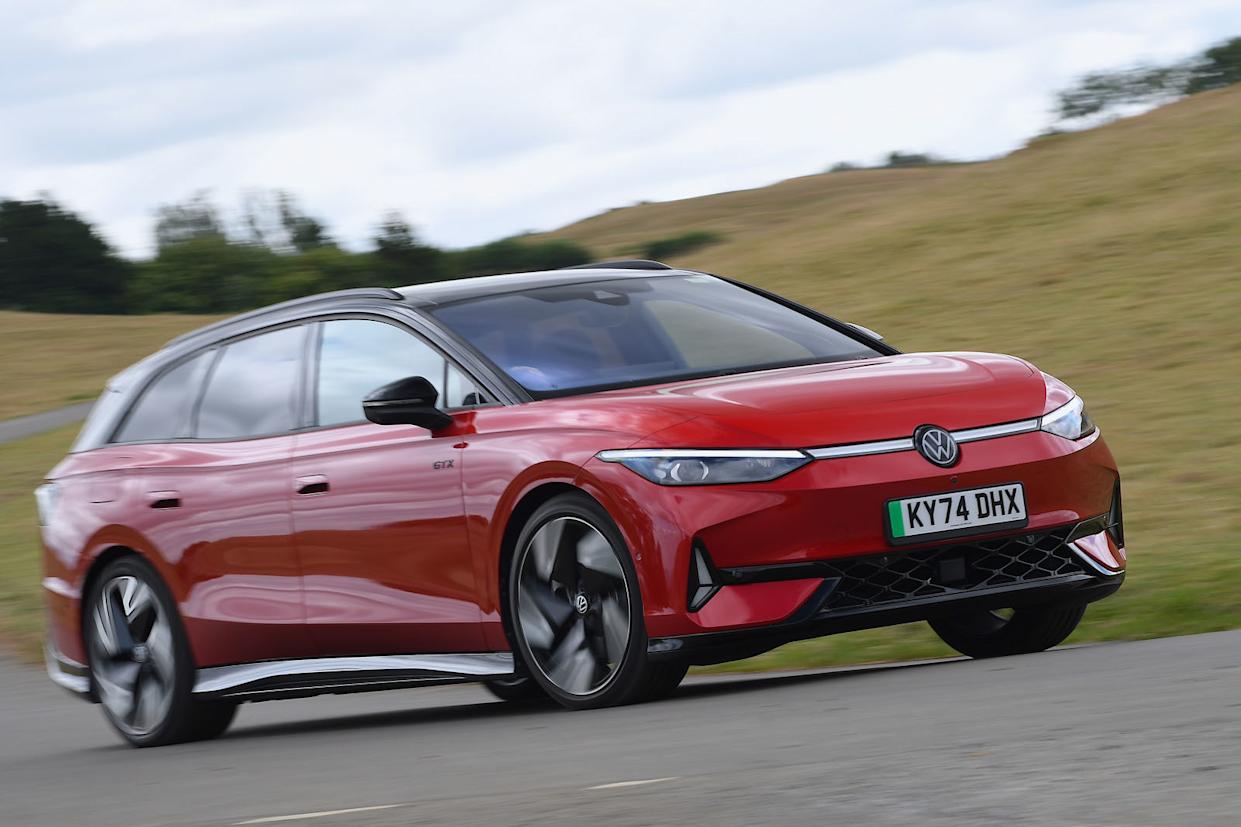
Introduction
Here comes a chance to run the road test ruler over the kind of Volkswagen we used to see fairly regularly some 25 years ago, during the firm’s ambitious Ferdinand Piëch-led management era that was seemingly defined by an agenda for giant-killing.
The Volkswagen ID 7 GTX isn’t quite the new, most expensive model in any VW showroom (that’ll still be the Volkswagen Touareg R PHEV, for as long as it lasts; which won't be much longer), but it’s getting warm. More significantly, it’s an all-electric gran turismo, available as either a liftback saloon or estate (we're testing the latter), with a dash of sporting appeal, a punchy £60k price, and clear designs on customers who might otherwise be shopping for Audis, BMWs and Mercedes-Benz models.
Has Volkswagen lost its marbles to think it can stretch MEB platform hardware that far? Or does it know something we don’t?
This is also the new de-facto flagship model of Wolfsburg’s GTX all-electric performance sub-brand (unless you count the more niche Buzz GTX). It should, therefore, give us a reliable indication of the scope of VW’s ambition for that sub-brand – and whether, in future, we should consider it more of a derivative trim level, or something worthy of greater anticipation among interested drivers.
Design & styling
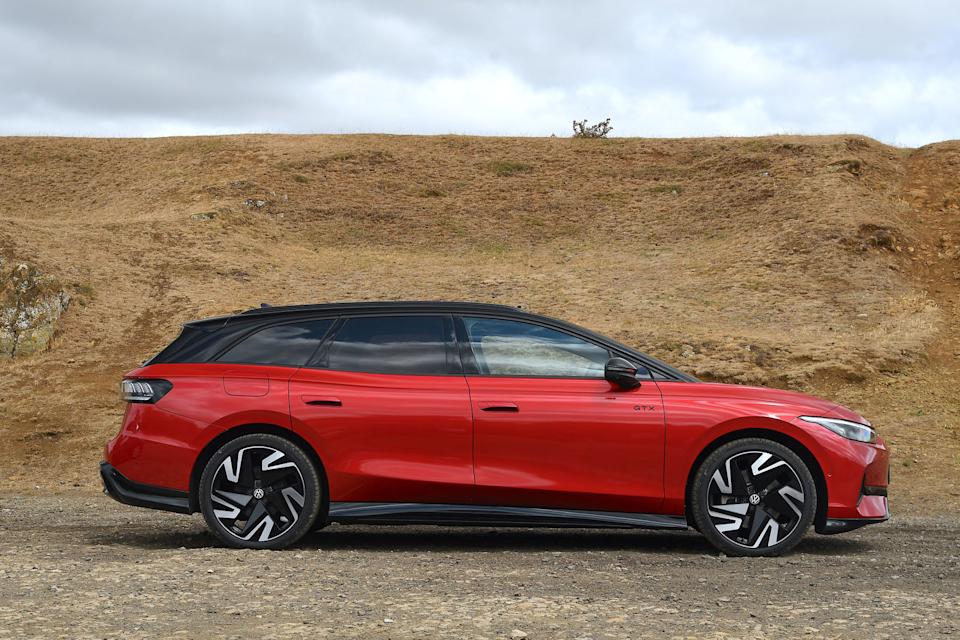
The Volkswagen ID 7 was launched in Europe late in 2023 and arrived here in early 2024, armed with only a single, rear-mounted drive motor, a 77kWh battery and a simple mission: to tempt people not to buy middle- ranking versions of the Tesla Model 3, BMW i4 and Polestar 2.
But VW was quick to expand the car’s model range, and later in 2024 it added the 86kWh battery that powers our test car. That can be specified with the car’s ‘default’ 282bhp single motor in the case of the Pro S version, or with twin motors and 336bhp in the GTX.
The latter gets its extra oomph from a small, secondary asynchronous drive motor (Volkswagen Group version number AKA150) on the front axle, from where it delivers up to 107bhp and 99lb ft. Because it’s asynchronous, it consumes negligible power when idle, so the car’s powertrain controller can summon its reserves at will. Quite why it only makes for an ID 7 GTX with 336bhp and 402lb in total – the latter no more than the single-motor Pro S model has – seems a little curious, but is likely to do with limited supply of current from the battery and inverter.
Our GTX Tourer test car weighed a hefty 2353kg on the proving ground scales. Taken even at the homologated kerb weight, it’s 104kg heavier than a single-motor Pro S. It’s also rated for a 60-mile shorter claimed electric range than its single-motor ‘inferior’ (due to the extra weight, more complicated powertrain and bigger wheels). So whether you’re sizing it up as a credible range-topping, grand touring flagship model or a serious alternative to a BMW i5 Touring or Audi A6 E-tron, VW’s numbers don’t make for the most auspicious start.
To look at, the car stands a better chance. It reminds you a little of the 1990s’ and noughties’ glory days of the premium estate – cars like the Alfa Romeo 156 Sportwagon and Lexus IS Sportcross. It’s not the most stunning shooting brake, but it is certainly a better-looking car than the equivalent ‘liftback’ saloon: its elongated profile hides the bulky ‘skateboard’ underfloor battery packaging a bit better. The GTX version gets a derivative-specific axle specification with its own coil spring and anti-roll bar settings; its own calibration for the Dynamic Chassis Control adaptive dampers that come as standard on UK-market cars; passive variable-ratio ‘progressive’ steering as standard; and 20in alloy wheels out of the box – or optional 21in alloys, as fitted to our test car.
The exterior styling changes that mark out the GTX from standard versions of the ID 7 are subtle but notable. There's a new front bumper design exclusive to the performance line, along with revamped daytime running lights and a gloss-black front air intake. The bumper is aerodynamically styled to aid efficiency, while the front-end design now features a light-up VW logo as standard.
At the rear, there's a bespoke horizontal light strip (the rear VW badge illuminates as well) and customisable 3D-effect LED clusters. On the saloon version, the lower area of the rear bumper features a honeycomb grille pattern and there's a notable diffuser.
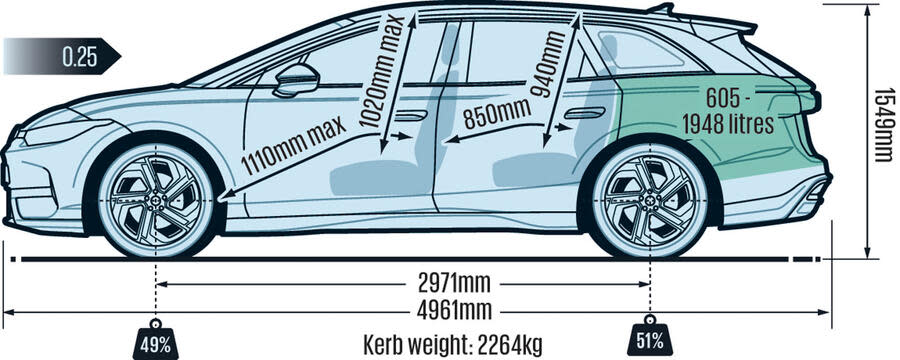
Interior

Volkswagen has a long tradition of studious understatement when it comes to the interiors of its special performance derivatives, and the ID 7 GTX follows that assiduously.
Where our single-motor Pro Match road test car of 2024 had blue decorative piping for its part-leather ErgoActive front seats and across its fascia, the GTX has red. There’s GTX detailing on the seat backrests and GTX badging on an otherwise identical steering wheel.
Mostly, that’s it. Neither the car’s standard-fit downsized instrument screen nor its upsized head-up display have any special GTX design theme, nor its 15in free-standing multimedia screen. There are no secondary controls particular to the GTX version, either.
Given that one of our reservation about the regular ID 7’s interior was its slight sense of plainness relative to premium-brand opponents, you might have expected VW to have seized the opportunity to up the richness with the GTX version – but no. The car does get, as standard, the colour-selectable ambient lighting for its dashboard and door cards that other ID 7s only get as an option, but this doesn’t really make the interior stand out.
But while it may not seem very special, none of this should suggest that it isn’t perfectly agreeable, comfortable and spacious. Our test car came with VW’s electrochromatic panoramic glass roof, which added an even greater sense of space, while the back seats especially really do afford quite a lot of room to stretch out in. Rear leg room, at a typical 850mm, beats even a Mercedes-Benz EQS.
The front seats are excellent, offering great leg support and touring comfort along with ventilation and massage functions. VW’s current preference for a column shifter opens up abundant centre console storage space, which can be neatly closed off when you don’t need it. And all the amenities your daily life might require – device charging pads and ports, removable cupholders, bigger covered storage areas – are present. The sense that VW has created a cabin more for living with than cooing at is very much apparent. That, of course, is very much its style, even if much particular performance flavour is lacking.
The philosophy extends to a boot that’s more than a metre long up to the rear seatbacks, more than a metre wide at its widest, and 750mm deep with its height- adjustable floor at its lowest (Audi S6 E-tron 690mm, Skoda Superb Estate 800mm), making the load space a very useful size overall.
Multimedia - 3.5 stars
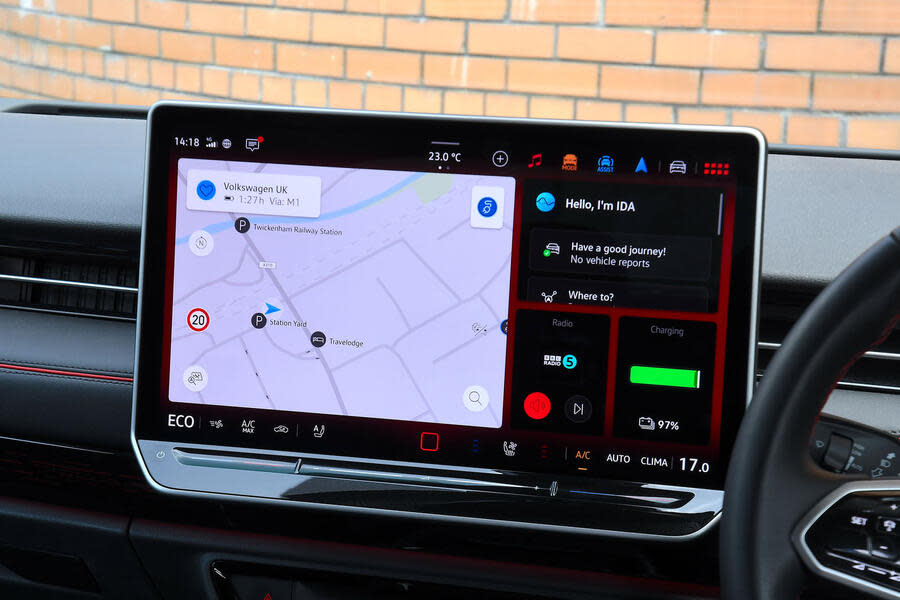
The 15in Discover Pro touchscreen infotainment screen of the ID 7 GTX retains across its lower edge the ‘touch slider’ tactile controls for the heater and volume control. Even after familiarisation, they remain unintuitive and, as the only physical controls for a system with a lot of ground to cover, still seem a strange inclusion, particularly given that there isn’t any cursor controller on the steering wheel, for instance.
There’s no option but to use the touchscreen interface. But as you do, you realise that accessibility of key functions is quite good: VW puts user-selectable shortcut icons, at a practical size, on the upper margin of the screen (so drive modes and ADAS settings are always close at hand), along with a fixed one to get directly in and out of smartphone mirroring. A home screen with a usefully flexible layout is also a welcome feature, so you’re seldom denied what information you might prefer displayed prominently.
Overall, you’d say more – and more conventional – physical controls would still be better. VW remains set on putting everything on a screen, but at least it’s finding better ways to do it over time.
Engines & performance
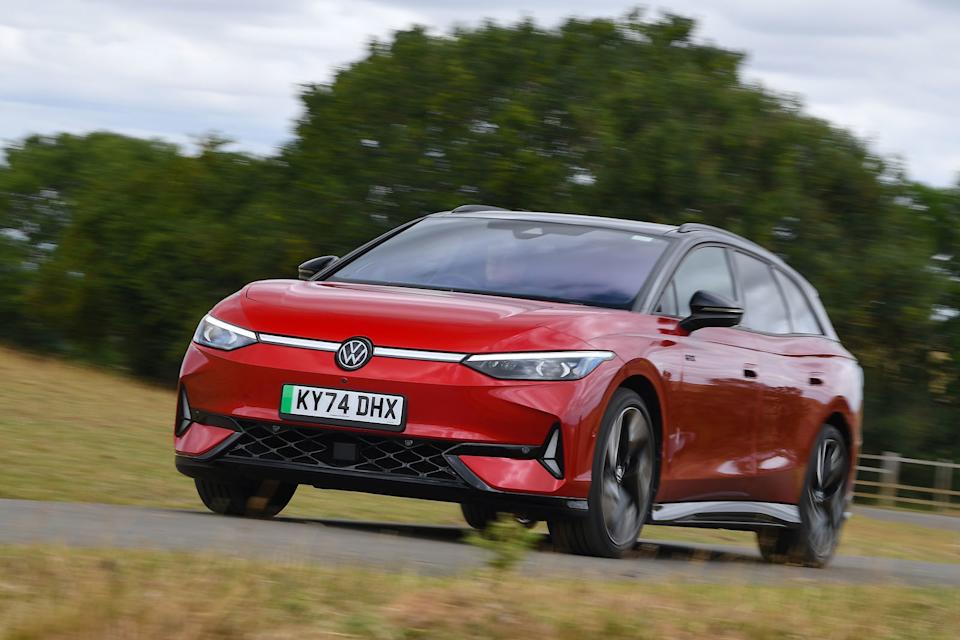
The ID 7 GTX Tourer takes an unusually mature attitude to life as a full-size modern performance EV. It’s not unlikeable, but neither is it very exciting – and it doesn’t rank among the more obviously ‘dynamic’ executive options on which you might spend upwards of £60,000 in 2025.
It doesn’t exactly rocket away from rest: our test car needed 5.3sec to hit 60mph and 13.3sec to hit 100mph (a single-motor, entry-level BMW i5 eDrive40 is almost as quick in the former respect, and a fair bit quicker in the latter). Meanwhile, there are plenty of cars offering varying equivalencies of the ID 7 Tourer’s space and versatility, from a Polestar 4 Long Range Dual Motor to a Kia EV6 GT, but with more than 500bhp, and a 0-62mph time of less than 4.0sec, and for the same money.
So a GTX buyer is unlikely to be one who is motivated by performance on its own. Not that they would be likely to consider this car slow. It has the power to get up to motorway speeds briskly, whisk itself away from roundabouts and through corners assertively, and execute A-road overtakes as decisively as you will ever be likely want or need. But this is not an EV that’s going to cause sharp intakes of breath or bouts of involuntary sniggering from either its driver or their passengers.
And it would be easier to engage with as a driver’s car if Volkswagen had provided manual brake regen control paddles. As it is, you can only tailor the car’s propensity to either coast or regen via a combination of drive modes: Sport comes with plenty of regen, while Comfort and Eco don’t; in Individual you can choose. Meanwhile, you can switch between adaptive (D) and heavier regen (B) on the drive selector.
That means Sport mode is off limits if you don’t like de-facto one-pedal driving. Moreover, there’s no quick-fire way to fine-tune the car’s coasting settings “on the fly”. Interestingly, sibling brand Cupra has that avenue covered with the related Born VZ. So we know that the hardware doesn’t forbid it.
It also puts a lot of onus on the car’s brake pedal to feed in regenerative braking as and when you need it – which it does only moderately well, with the pedal having a soft, long-travel feel that seems to struggle to ramp up regenerative force very progressively as you add pressure, only to trigger the friction brakes quite suddenly and without great tactile signalling. Here, just as with the regen control, we expect better of an avowed driver’s car.
Acceleration from rest
(at >90% charge, above; <10% charge, below)

Braking from 70mph
(dry surface, above; wet surface, below)


Braking endurance
(damp surface)
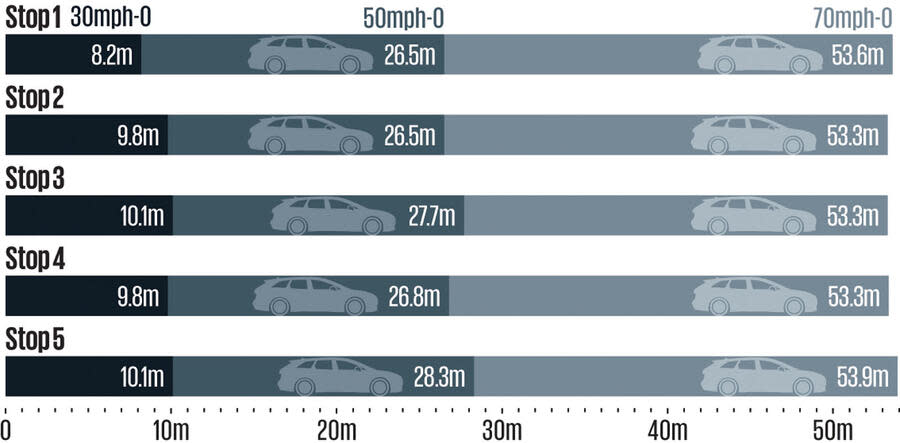
Ride & handling
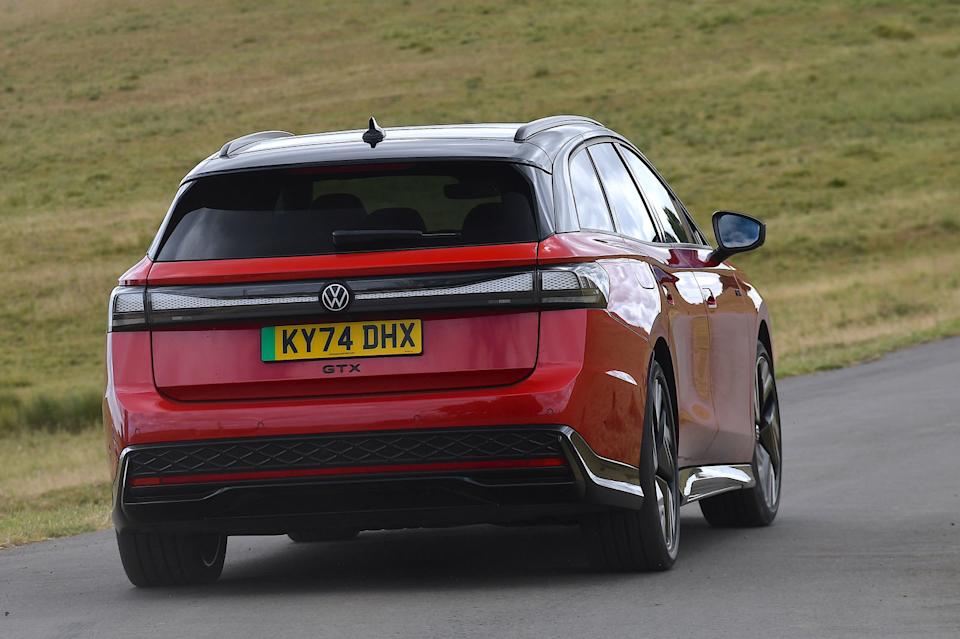
The single-motor ID 7 is a car that’s clearly comfortable sitting at the less sporting end of the dynamic spectrum for medium-sized EVs. It is a fairly gentle-steering, supple-riding thing, with a loping sense of cruising comfort brought on by its long wheelbase, but no particular or apparent ambitions towards athleticism. As a foil to the Teslas, Polestars and BMW i cars that it’s up against, therefore, it could be quite an appealing proposition.
That doesn’t make for the most promising dynamic foundation for a performance model, though. The GTX adds some marginal but clear gains on mechanical grip and country-road body control into the ID 7’s established mix. It doesn’t try, however, to be transformatively different in respect of its handling agility, its cornering balance, its big-car stability or the way in which it vectors its torque.
This is at least 80-85% the recognisable ID 7 driving experience, then, with some extra high-speed precision and composure thrown in. The GTX is a version of the car that is better suited to fast touring, perhaps, but it is not an out-and-out entertainer.
It has medium-paced steering that is shy of tactile feedback, as it ramps assistance up and down to render ‘invisible’ the effect of its varying directness. And it comes with Dynamic Chassis Control dampers that can be dialled up or down to create relatively taut and short or, alternatively, soft and languid body movements; but they ultimately struggle to entirely redefine the dynamic potential of the car.
With those dampers at their firmest, the ride becomes a little brittle and tetchy: the GTX proves to be too long and heavy to really play the natural sports saloon effectively. At their softest, meanwhile, while they allow for a much more relaxed gait that makes for fairly pleasant longer-distance mile-covering, they occasionally allow the 21in wheels too much freedom to thunk and clunk over raised edges and through sunken drains.
In short, the GTX makes for a more natural grand touring cruiser than anything else. It contains its 2.3-tonne bulk competently in quicker cross-country driving, but it never really escapes the neutering influence of that mass.
Cabin noise

Track notes - 2.5 stars
Horiba MIRA’s handling circuits showed that the ID 7 GTX lacks any real torque-vectoring smarts and, just as on the road, it struggles with its sheer size and bulk.
On the dry handling track it controlled its body well and had good stability when cornering quickly. But, regardless of the ESC setting, it tended towards a persistent nose-led attitude at the limit of grip, and there was no mitigating it with either trail- braking or the application of power.
On the wet handling track, the car’s mass felt like more for its tyres to contain. It would at least begin to roll into trailing-throttle oversteer on entry to quicker bends, before the stability control acted to correct the car’s attitude. Here, in lower-grip circumstances, it’s possible to get the chassis to powerslide – but only fleetingly and with constant positive steering angle.
On both circuits, the soft brake pedal made commitment to corners less tidy than it should have been.
MPG & running costs
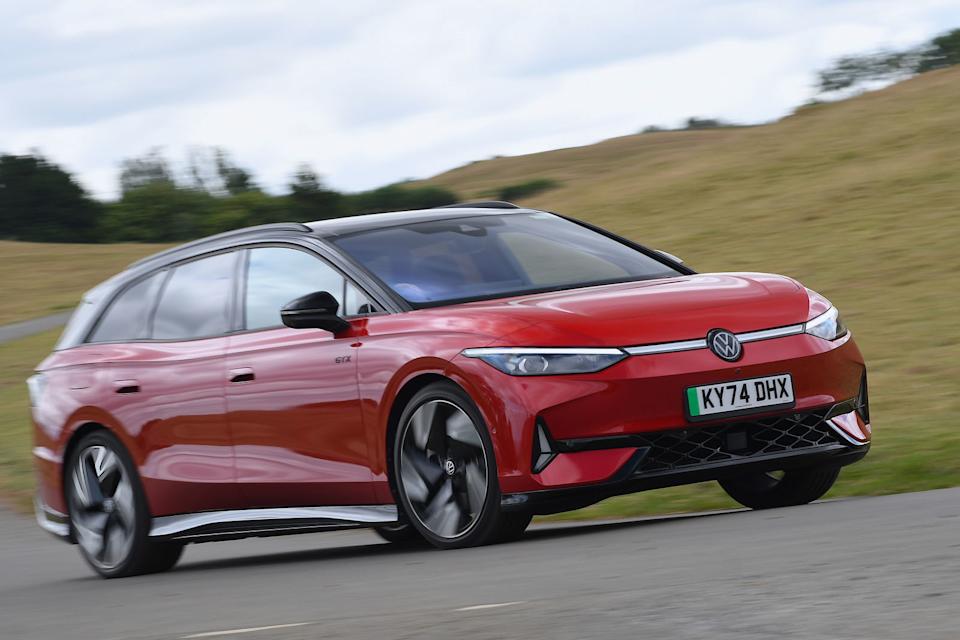
The £63,000 asking price of our test car puts the ID 7 GTX Tourer in with plenty of more powerful opponents and uncomfortably close to more premium propositions. But Volkswagen already seems to be sweetening this car’s bargain. Configure a like-for-like car as ours today and it’ll come with an RRP nearly £3000 lower (it’s much too expensive to qualify for the UK government’s recently reinstated EV purchase incentives).
Secured for less than £60k, the GTX would stand a better chance. Given its positioning it needs a decent price advantage, versus not only real premium choices such as the BMW i5 and Audi A6 E-tron but also many other performance EVs.
Being so heavy – and rolling on optional 21in wheels, which will have had an impact – our test car wasn’t particularly efficient. A touring-test result of 2.9mpkWh was nearly 20% poorer than the single-motor ID 7 tested last year, and that more than overcame any improvement to range the car’s increased battery capacity might otherwise have delivered.
As it was, a 249-mile real-world motorway range is a bit disappointing for the price. Moreover, the GTX failed to better the regular ID 7’s weighted average DC rapid charge test result (116kW versus 120kW).
DC rapid charging test

Running efficiency
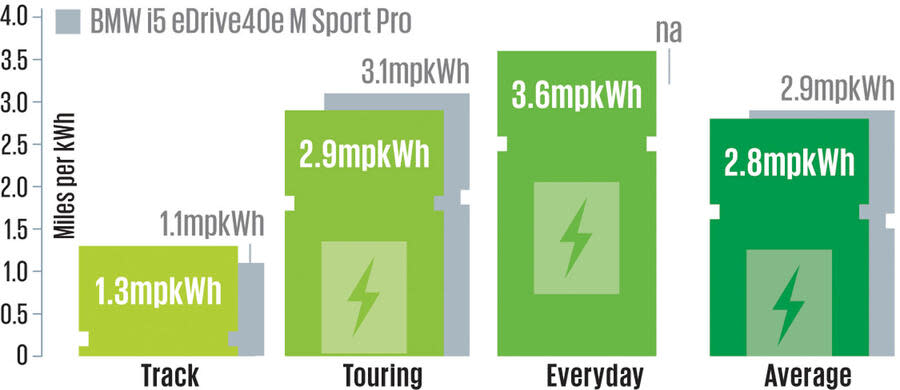
Verdict
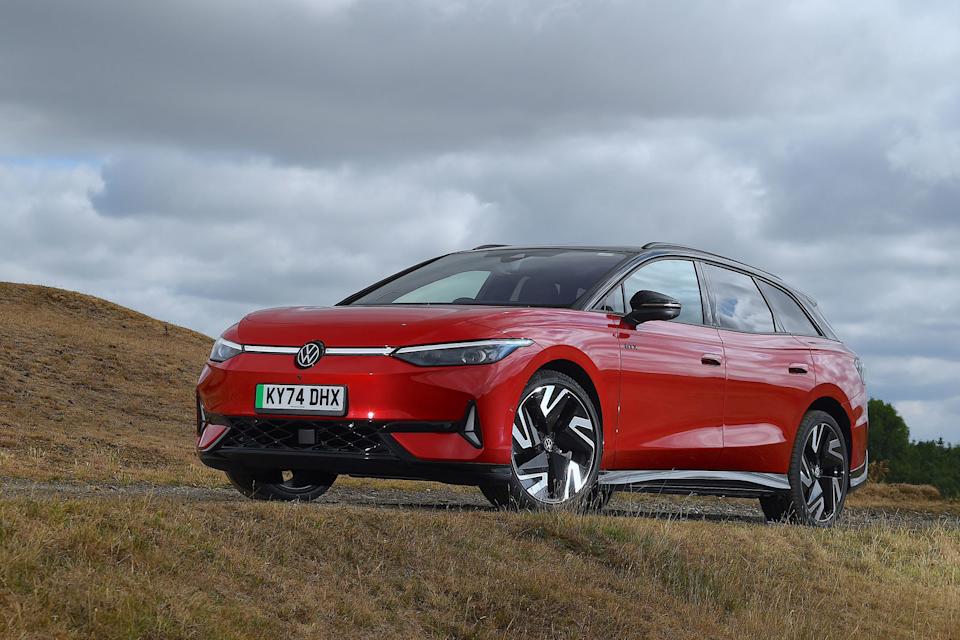
Volkswagen was one of the first electrification champions to explore performance treatments but, as yet, GTI hasn’t begotten GTX quite as successfully as we might have expected.
This sub-brand is being left behind as Hyundai, Kia, Alpine, Polestar and Cupra break the ground instead. GTX needs a car to reclaim credibility and reaffirm its intent, but the ID 7 GTX Tourer isn’t it.
This car extends the capabilities and dynamic range of the fairly laid-back EV on which it is based only by degrees. That is perhaps as intended; as a fairly fast electric executive option, to live with and take a little extra enjoyment from, it succeeds in its moderate, understated way.
But it will have a hard time cutting through in a segment packed with bigger-toothed rivals, each conferring greater status or delivering greater driver appeal in its different way.
]]>
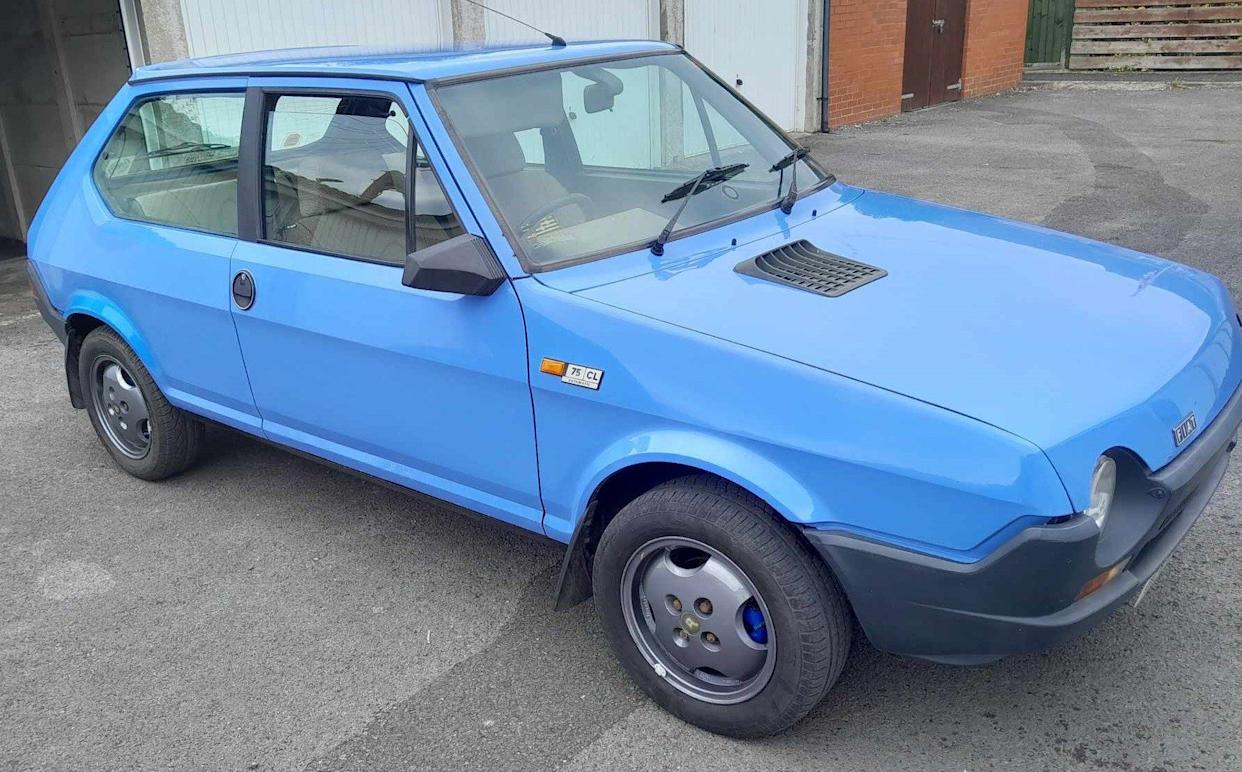

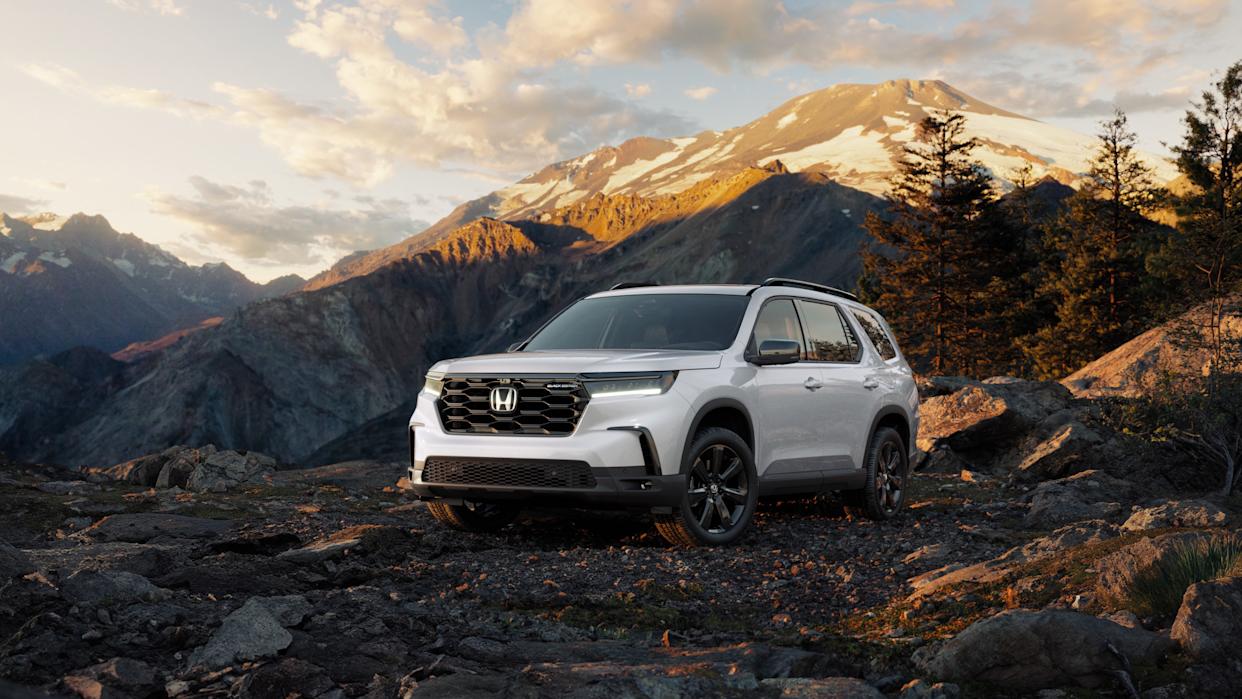
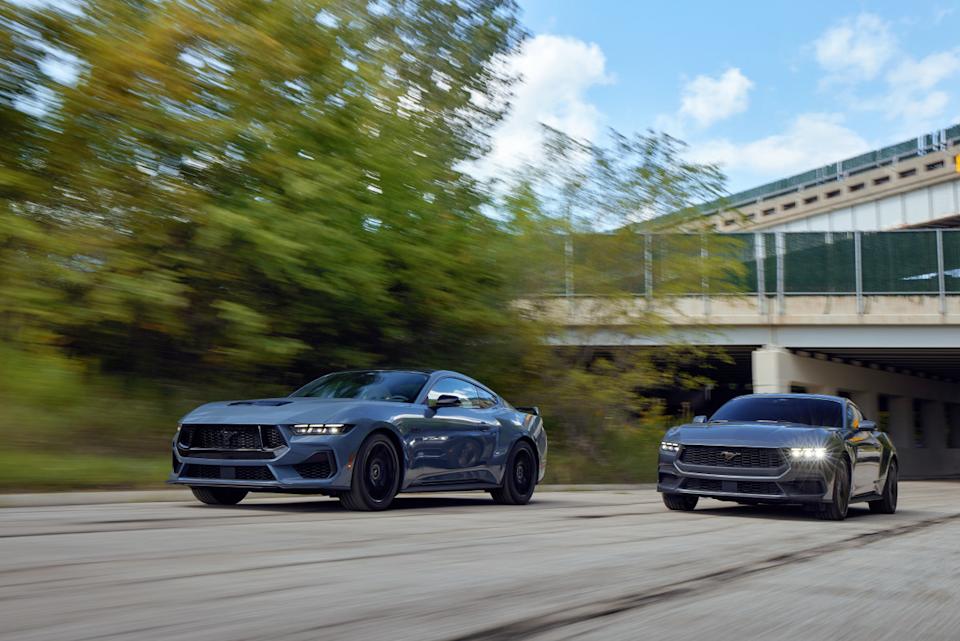
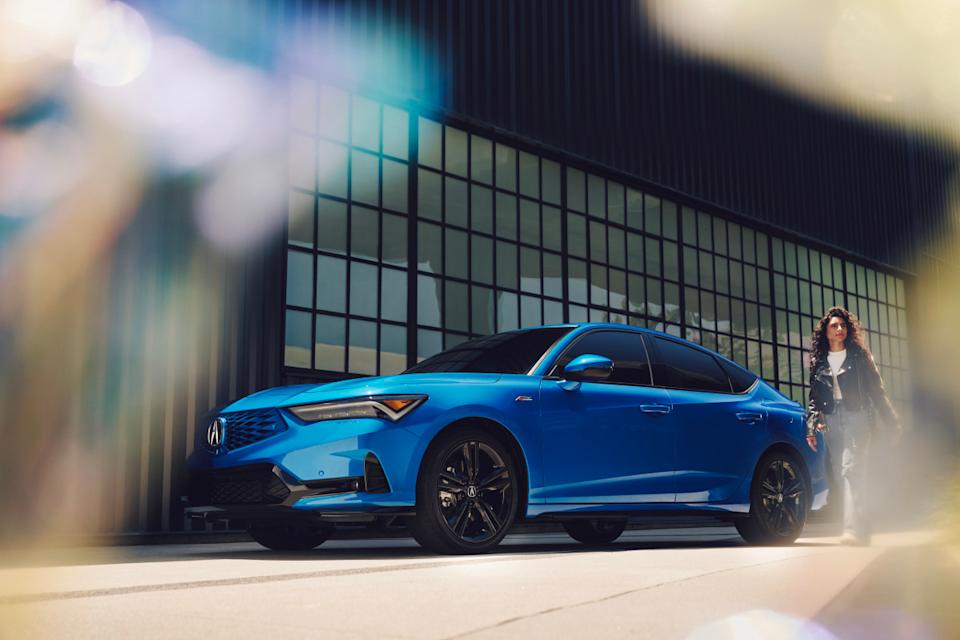
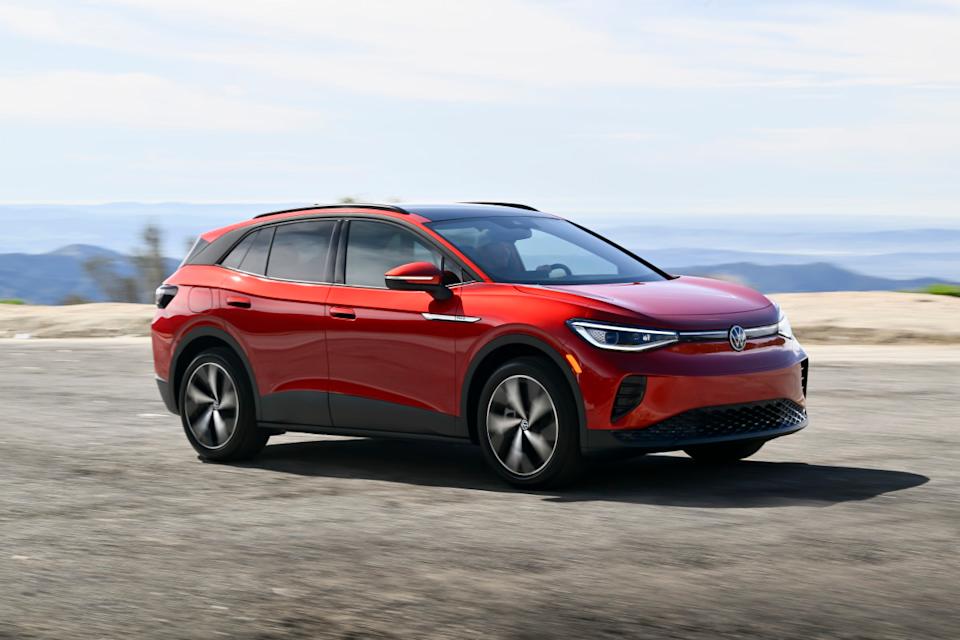

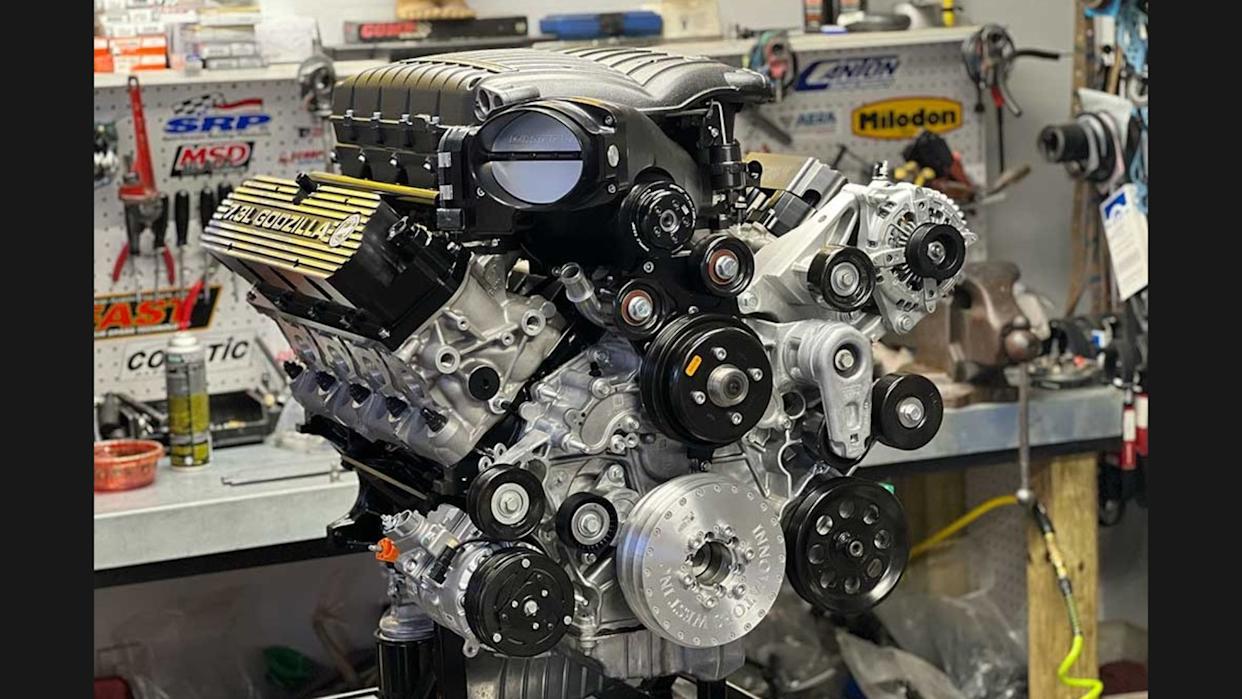
Comments